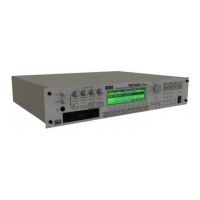Appendices
233
O
Oscillator Mode conflicts (check PROG 2.1)
P
Pattern used in song Continue ?
R
Rear sample is empty
Root directory is full
S
Sample data used in other sample(s) Continue ?
Sample L and R are identical
Sample length is shorter than minimum
Sample used in other multisample(s) Continue ?
Selected banks are the same
Selected file/path is not correct
Slice point over limit Can’t divide
Source is empty
Source sample is empty
T
There is no readable data
This file is already loaded
U
Unable to create directory
Unable to save file
Meaning: In Sampling mode when you executed “Conv. To
Program” with Use Destination Program Parame-
ters checked, the conversion destination program
“Mode (Oscillator Mode)” setting did not match.
Action: In Program mode, set the “Mode (Oscillator
Mode)” of the conversion destination program. If
converting a monaural multisample, select Single.
If converting a stereo multisample, select Double.
Meaning: When editing, the specified pattern is used by
RPPR. If you wish to execute, press the [F8]
(“OK”) key. If you decide not to execute, press the
[F7] (“Cancel”) key.
Meaning: When executing the Sampling mode function
Sample Edit “Link,” the sample specified as the
rear sample was empty.
Action: Specify a rear sample that contains data, and exe-
cute the function once again.
Meaning: You attempted to create a file or directory in the
root directory of the media, but this would exceed
the maximum number of root directory entries.
Action: Either delete an existing file or directory, or
exchange media.
Meaning: Other sample(s) use the same sample data as the
sample that you are editing. To continue editing,
press the [F8] (“OK”) key.
Meaning: The edit operation could not be executed because
the destination (save location) L and R sample
numbers are identical.
Action: Select different sample numbers for L and R of the
destination (save location).
Meaning: You attempted to execute an editing operation
that would make the sample data shorter than 8
samples.
Action: Change the editing range so that the sample data
will be longer than 8 samples.
Meaning: The sample you are editing is used by other multi-
samples. To continue editing, press the [F8]
(“OK”) key.
Meaning: This is a dialog box displayed when you load a
TRITON .PCG file that contains drum kit banks
C/D/User or user arpeggio banks C/D, and indi-
cates that the specified loading destination bank is
the same bank.
Action: Press the [F8] (“OK”) key to acknowledge the
error message, return to the dialog box where you
specify the bank, and re-specify the loading desti-
nation bank.
Meaning: When loading a KSF file that was split across mul-
tiple media, the order in which you attempted to
load the files was incorrect.
Action: Load the KSF file in the correct order. To view the
file number order in which the KSF files were
saved, you can check the Utility “Translation.”
(The sample name and number of the first KSF file
will be displayed.)
Meaning: The Sampling mode “Time Slice” function or the
“Time Stretch” Slice function would divide the
sample into more samples than the maximum
(1000), so “Divide” cannot be executed.
Action: Use “Link” to connect any “Index” that does not
need to be divided; then execute “Divide.”
Meaning: No data exists in the pattern that you specified as
the source.
Action: Specify a pattern that contains musical data.
Meaning: When executing Insert, Mix, or Paste, the source
sample is empty.
Action: Execute the Copy operation before executing
Insert, Mix, or Paste.
Meaning: Either the file size is 0 or the file does not contain
data that can be accessed by the load or open
operation. Alternatively, the data is damaged etc.,
and cannot be loaded or accessed.
Meaning: When loading a divided .PCG file, you attempted
to load a file that had already been loaded.
Action: Load the .PCG files that have not yet been loaded.
Meaning: You attempted to create a directory that would
exceed the maximum pathname length (76 charac-
ters for the full pathname).
Meaning: When executing the Disk mode Utility “Copy,”
the copy destination path length exceeded 76
characters.

